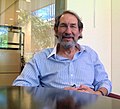Attēls:Geoffrey West.jpg

Šī priekšskata izmērs: 661 × 600 pikseļi. Citi izmēri: 264 × 240 pikseļi | 529 × 480 pikseļi | 846 × 768 pikseļi | 1 128 × 1 024 pikseļi | 1 322 × 1 200 pikseļi.
Sākotnējais fails (1 322 × 1 200 pikseļi, faila izmērs: 559 KB, MIME tips: image/jpeg)
Faila hronoloģija
Uzklikšķini uz datums/laiks kolonnā esošās saites, lai apskatītos, kā šis fails izskatījās tad.
| Datums/Laiks | Attēls | Izmēri | Dalībnieks | Komentārs | |
|---|---|---|---|---|---|
| tagadējais | 2007. gada 30. jūlijs, plkst. 12.53 |  | 1 322 × 1 200 (559 KB) | FlickreviewR | Replacing image by its original image from FlickR |
| 2007. gada 30. jūlijs, plkst. 06.44 |  | 1 024 × 930 (547 KB) | PDH | {{Information |Description= "As animals get bigger, from tiny shrew to huge blue whale, pulse rates slow down and life spans stretch out longer, conspiring so that the number of heartbeats during an average stay on Earth tends to be roughly the same, arou |
Faila lietojums
Šo failu neizmanto nevienā lapā.
Globālais faila lietojums
Šīs Vikipēdijas izmanto šo failu:
- Izmantojums ar.wikipedia.org
- Izmantojums azb.wikipedia.org
- Izmantojums de.wikipedia.org
- Izmantojums en.wikipedia.org
- Izmantojums en.wikiquote.org
- Izmantojums fa.wikipedia.org
- Izmantojums fa.wikiquote.org
- Izmantojums fr.wikipedia.org
- Izmantojums gd.wikipedia.org
- Izmantojums hy.wikipedia.org
- Izmantojums it.wikipedia.org
- Izmantojums ja.wikipedia.org
- Izmantojums ko.wikipedia.org
- Izmantojums nl.wikipedia.org
- Izmantojums pa.wikipedia.org
- Izmantojums pl.wikipedia.org
- Izmantojums pnb.wikipedia.org
- Izmantojums sr.wikipedia.org
- Izmantojums sv.wikipedia.org
- Izmantojums vi.wikipedia.org
- Izmantojums zh.wikipedia.org
